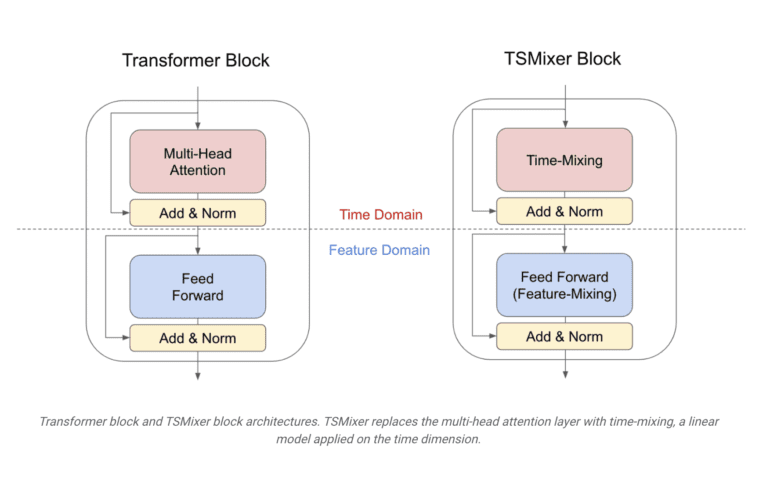TL;DR:
- Time-Series Mixer (TSMixer) is Google AI’s innovative solution for long-term forecasting.
- TSMixer bridges the gap between univariate linear models and Transformer-based architectures.
- It combines static temporal pattern capturing of linear models with dynamic cross-variate information processing of Transformers.
- TSMixer outperforms other models in mean squared error (MSE) on seven prominent long-term forecasting datasets.
- The results highlight the potential of well-designed multivariate models in competing with univariate counterparts.
Main AI News:
In today’s dynamic landscape of data-driven decision-making, the accuracy of time series forecasting holds paramount significance across various real-world domains. Be it predicting market demand trends or anticipating the trajectory of global health crises, the ability to make precise forecasts remains invaluable. Within the realm of multivariate time series forecasting, two primary categories of models have emerged: univariate and multivariate. Univariate models focus on capturing trends and seasonal patterns within single-variable time series, emphasizing inter-series interactions. However, recent research has illuminated an intriguing conundrum: despite the considerable promise they hold, advanced multivariate models often fall short of the benchmark performance achieved by straightforward univariate linear models in the context of long-term forecasting. This raises pivotal questions about the efficacy of cross-variate information and the enduring relevance of multivariate models in scenarios where such information may not offer a substantial advantage.
The landscape of time series forecasting has witnessed the ascendancy of Transformer-based architectures in recent years, largely owing to their remarkable performance in sequence-related tasks. Nevertheless, their efficacy in long-term forecasting benchmarks has sparked debates about their superiority over simpler linear models. Addressing this challenge head-on, the Google AI team introduces a groundbreaking solution: Time-Series Mixer, or TSMixer for short. Conceived after a meticulous analysis of the strengths exhibited by univariate linear models, TSMixer marks a significant leap forward in the field. It harnesses the inherent capabilities of linear models while adeptly integrating cross-variate information, resulting in a model that not only rivals but often surpasses the performance of the best univariate models in long-term forecasting benchmarks.
A pivotal point of distinction between linear models and Transformers resides in their methods of capturing temporal patterns. Linear models employ fixed, time-step-dependent weights to capture static temporal patterns, rendering them exceptionally proficient at acquiring such patterns. In contrast, Transformers rely on attention mechanisms featuring dynamic, data-dependent weights, allowing them to capture dynamic temporal patterns and facilitate the processing of cross-variate information. The ingenious TSMixer architecture amalgamates these two approaches, thereby ensuring that it retains the temporal modeling prowess of linear models while harnessing the computational potency inherent in cross-variate information.
As the adage goes, “Metrics don’t lie,” and in the case of TSMixer, the results resoundingly attest to its prowess. When subjected to rigorous evaluation against seven prominent long-term forecasting datasets encompassing domains such as Electricity, Traffic, and Weather, TSMixer exhibits a substantial enhancement in mean squared error (MSE) when compared to other multivariate and univariate models. This empirical evidence unequivocally underscores that, when meticulously designed with precision and insightful amalgamation of methodologies, multivariate models can indeed compete on an equal footing with their univariate counterparts in the realm of long-term forecasting.
Conclusion:
TSMixer’s emergence signifies a significant leap in the field of long-term forecasting, bridging the gap between linear models and Transformers. Its superior performance in benchmark tests suggests that well-designed multivariate models can be competitive with univariate models. This development offers businesses and industries a robust tool for making more accurate long-term forecasts, potentially leading to improved decision-making and operational efficiency.

